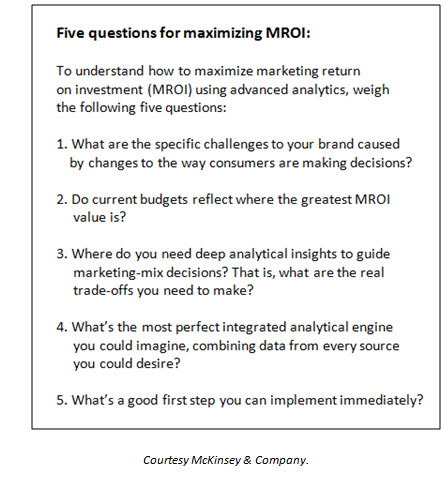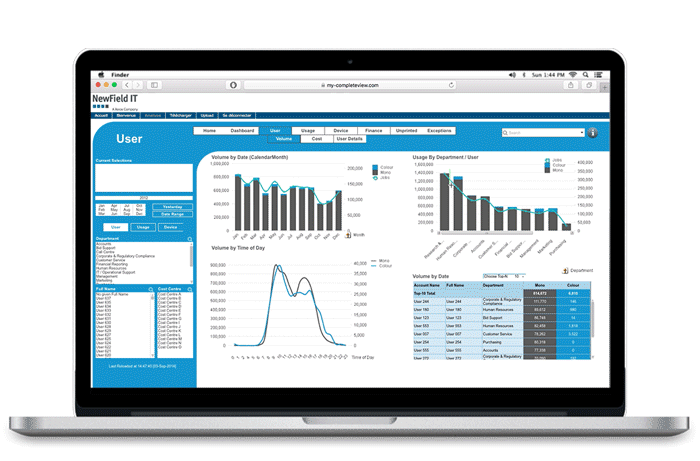Data for the sake of data accomplishes nothing, and few managers would waste their budget on data capture without having a strategy for using the data. Often that plan involves studying data to identify and correct operational problems. Research from Forrester confirms that, noting, “Analytics capabilities skew toward operations and risk rather than growth” by a rate of 91 percent to 50 percent. That’s not surprising, considering all the operational uses of business data:
- Process optimization
- Supply chain improvements
- Maintenance scheduling
- Security monitoring
- Regulatory compliance
Insights into how you might serve customers faster, shave days off of a process or eliminate expensive manual workflow steps can improve profitability and drive business growth. Data to drive these goals is very attainable through the rich set of analytics available through a good Next-gen MPS program:
Maturity Analytics – Using standard questions, maturity analytics measures current MPS maturity and identifies opportunities for improvement. It determines the current state of your MPS engagement against your core business values and benchmarks your organization against industry peers. A future state is then defined with an associated road map.
Device Analytics – Device Analytics captures volume, financial and environmental impact data about your printer fleet. Analytics can identify conditions like device underutilization or areas of the business that are spending too much on color printing. From this fact-based information comes a design for an optimized future state that delivers value like reduced TCO or more sustainable printing practices.
User Analytics – User Analytics doesn’t just detect problems; it spots potential areas of opportunity within your business. User Analytics drills down to the level of individual print jobs. Behavior patterns and anomalies are revealed through data collected from various print management systems. When you know how, what, when and where users print, it’s easier to identify unusual or inefficient printing.
Document Analytics – This step reveals why users print and identifies processes with lots of touch points, often a flag for an inefficient workflow. Document Analytics probes the processes contributing to a specific print behavior, along with reasons for printing and the fate of documents, whether stored, shredded or shared. Processes with high opportunity scores can be targeted for an in-depth Process Analytics study.
Process Analytics – Process Analytics creates the business case for digital change. This stage maps the current state process on a step-by-step basis and identifies inefficiencies. Each step is mapped using data about:
- Specific process activity
- Owners of each step
- Time and costs associated with each step
- Documents and systems in use
- Value created at each step
From Data to Digital
Businesses large and small recognize the value of analytics. The challenge has been how to get at that value and turn it into something useful, like a roadmap to digital transformation. Wanting digital transformation is one thing, but knowing where to start is another. How does data help? It identifies areas that would most benefit from automation or digitization. MPS analytics have been designed with this objective in mind. A good MPS analytics program looks at the efficiency of your current system and the behavior both of your devices and the people who use them.
In this video from Xenith Document Systems[i], Newfield IT[ii] General Manager Kevin Conder talks about using MPS data to drive change and transformation. He covers these and other topics:
- A three stage process for introduce digital transformation into your business
- Advice on how to convince employees of the value of digital transformation
- A demonstration of Xerox’s Complete View and User Analytics tool
ARVE Error: Mode: lazyload not available (ARVE Pro not active?), switching to normal mode
Conder notes that over 80 percent of SMBs want to cut paper out of how they invoice, report financials, manage legal and HR forms, plus other time consuming processes. He points out that nearly half of these businesses waste significant amounts of time on paper-intensive processes, and 6 out of 10 say this has major impact on the bottom line. It’s a ready-made opportunity to make important changes driven by data and analytics.
Let analytics lead you to better understanding of your business, and point the way to continuous improvement. Check out the other videos in this series for more in-depth information to guide your journey.
[i] Xenith Document Systems is a leading provider of Managed Print Services, Document Solutions and Workflow Automation in London, United Kingdom. They are a Xerox Platinum Partner, winner of the Xerox MPS Partner of the Year award in the UK, and NewField IT’s Systems Integration Partner of the Year in the UK.
[ii] The assessment and analytics arm of Xerox, which awarded Xenith Document Systems their prestigious “Systems Integration Partner of the Year 2016” award – for pioneering the ability to understand customers’ true requirements through next-generation analytics.



